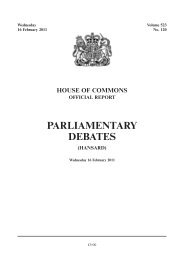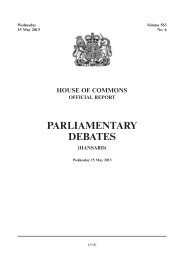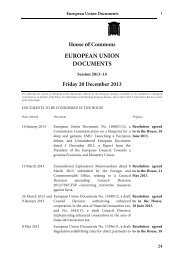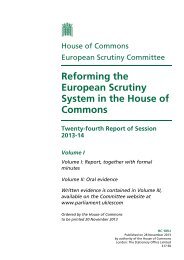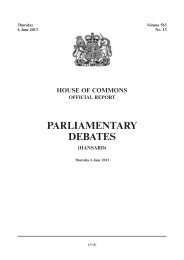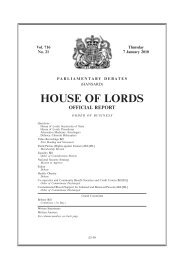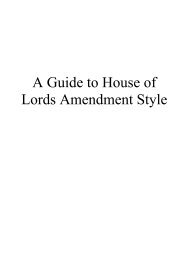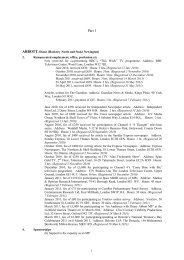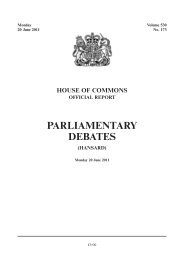View PDF - United Kingdom Parliament
View PDF - United Kingdom Parliament
View PDF - United Kingdom Parliament
You also want an ePaper? Increase the reach of your titles
YUMPU automatically turns print PDFs into web optimized ePapers that Google loves.
177W<br />
Written Answers<br />
26 OCTOBER 2009<br />
Written Answers<br />
178W<br />
(this may be because the person gave different names, or<br />
different versions of their name, on separate arrests, or<br />
because of upgrading of profiles). It is currently estimated<br />
that 13.8 per cent. of profiles held on the NDNAD are<br />
replicates. The replication rate of 13.8 per cent. should<br />
only be applied over the entire database however, as the<br />
replication rate for individual police forces varies<br />
considerably. The presence of these replicate profiles on<br />
the NDNAD does not impact on the effectiveness and<br />
integrity of the database.<br />
Table 1<br />
Force<br />
Number of subject profiles as at<br />
15 October 2009<br />
Number of individuals<br />
(estimated)<br />
Proportion of total subject<br />
profiles held on the NDNAD<br />
(percentage)<br />
Scotland 271,693 — 4.6<br />
England and Wales, inc. BTP 5,532,847 — 93.6<br />
Northern Ireland 74,431 — 1.3<br />
Other 1 31,201 — 0.5<br />
Total 5,910,172 5,094,568 100.0<br />
1<br />
For example, Guernsey police, Ministry of Defence police etc.<br />
Table 2<br />
Force<br />
Number of crime scene profiles as at<br />
15 October 2009<br />
Proportion of crime scene profiles on the<br />
NDNAD (percentage)<br />
Scotland 13,153 3.6<br />
England and Wales, inc. BTP 351,367 95.6<br />
Northern Ireland 1,753 0.5<br />
Other 1 1,262 0.3<br />
Total 367,535 100<br />
1<br />
For example, Guernsey police, Ministry of Defence police etc.<br />
Dogs: Animal Welfare<br />
Mr. Sanders: To ask the Secretary of State for the<br />
Home Department what recent trends he has identified<br />
in the prevalence of dog fighting in the UK; and what<br />
steps his Department is taking to encourage police<br />
forces to allocate adequate resources towards reducing<br />
the incidence of dog fighting. [294918]<br />
Jim Fitzpatrick: I have been asked to reply.<br />
Our regular meetings with the RSPCA include reviewing<br />
dog fighting issues, which has long been an illegal<br />
activity. It is premature to speculate on the basis of the<br />
available evidence whether there have been any significant<br />
trends in the prevalence of dog fighting.<br />
However, the Animal Welfare Act 2006 updated and<br />
strengthened the law on animal fighting. The Act created<br />
separate offences for animal fighting and significantly<br />
increased the maximum financial penalties available to<br />
the courts for such offences. Anyone found guilty of an<br />
offence related to animal fighting is liable to a maximum<br />
fine of £20,000 (previously £5,000), or six months’<br />
imprisonment, or both.<br />
We have also recently published new guidance for the<br />
police on the enforcement of dangerous dogs law as<br />
well as provided the Association of Chief Police Officers<br />
(ACPO) with £20,000 to assist in the training of police<br />
officers in the use of dangerous dogs law. The guidance<br />
and training includes the identification of illegal pit bull<br />
type dogs that are commonly used in dog fighting.<br />
The Home Office are legislating (in the Policing and<br />
Crime Bill) to create a new power to prevent gang-related<br />
violence. This will enable police or local authorities to<br />
ask the courts to prohibit gang members from doing a<br />
number of things, including being in charge of an<br />
animal in a public place.<br />
Drug Interventions Programme<br />
Chris Huhne: To ask the Secretary of State for the<br />
Home Department how many and what proportion of<br />
people arrested and tested under the Drug Interventions<br />
Programme were positive for (a) heroin and (b) crack<br />
cocaine in each police force area in each year since 2003.<br />
[294178]<br />
Alan Johnson: The drug testing of offenders for specified<br />
Class A drugs (heroin and cocaine/crack) in police<br />
custody came into operation from 2003 across 30 Basic<br />
Command Units (BCUs) as part of the Drug Interventions<br />
Programme (DIP). Since that time the programme has<br />
expanded in a phased approach to 66 BCUs in 2004 and<br />
some 107 BCUs in 2005. DIP currently conducts drug<br />
testing in 109 BCUs across England and Wales.<br />
Only offenders arrested or charged with a “trigger<br />
offence”—largely acquisitive crime related offences—are<br />
required to provide a sample to be tested for specified<br />
Class A drugs.<br />
Tables 1, 2 and 3 show the number of positive tests<br />
under the Drug Interventions Programme for heroin<br />
only, cocaine only, and heroin and cocaine combined,<br />
for each financial year since data was available.<br />
Table 1: Heroin only<br />
Force 2004-05 2005-06 2006-07 2007-08 2008-09<br />
Avon and Somerset 223 213 408 319 334<br />
Bedfordshire 179 223 328 90 165<br />
Cambridgeshire 164 157 277 196 244<br />
City of London — — 124 84 102<br />
Cleveland 596 516 1,073 988 1,031



